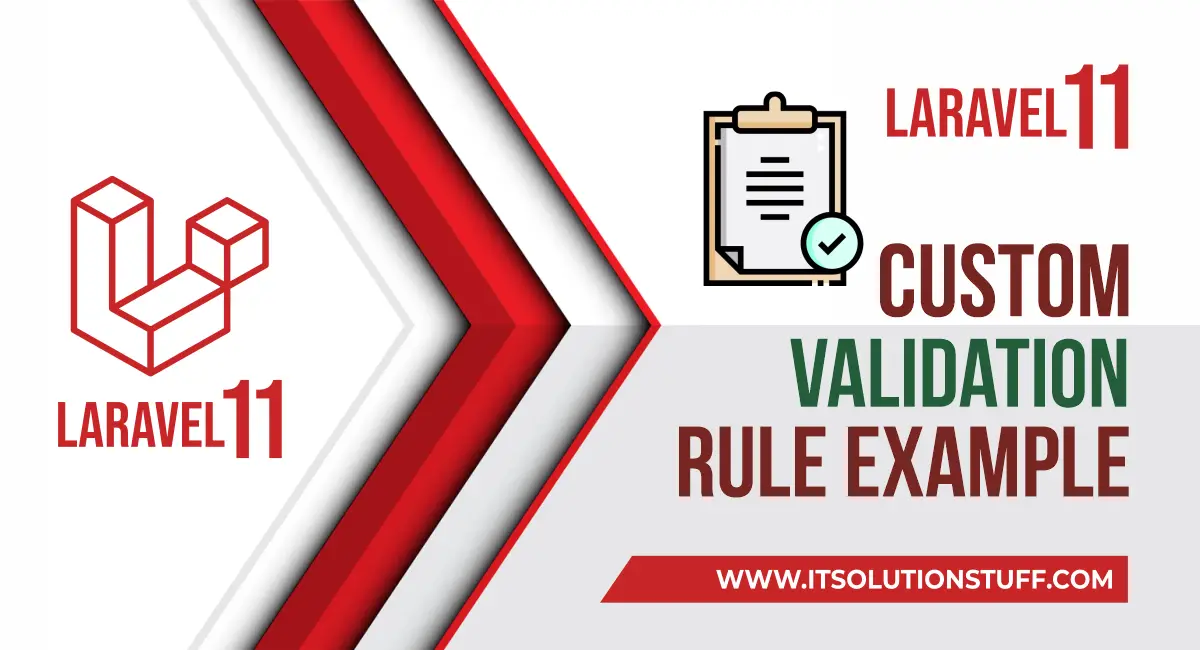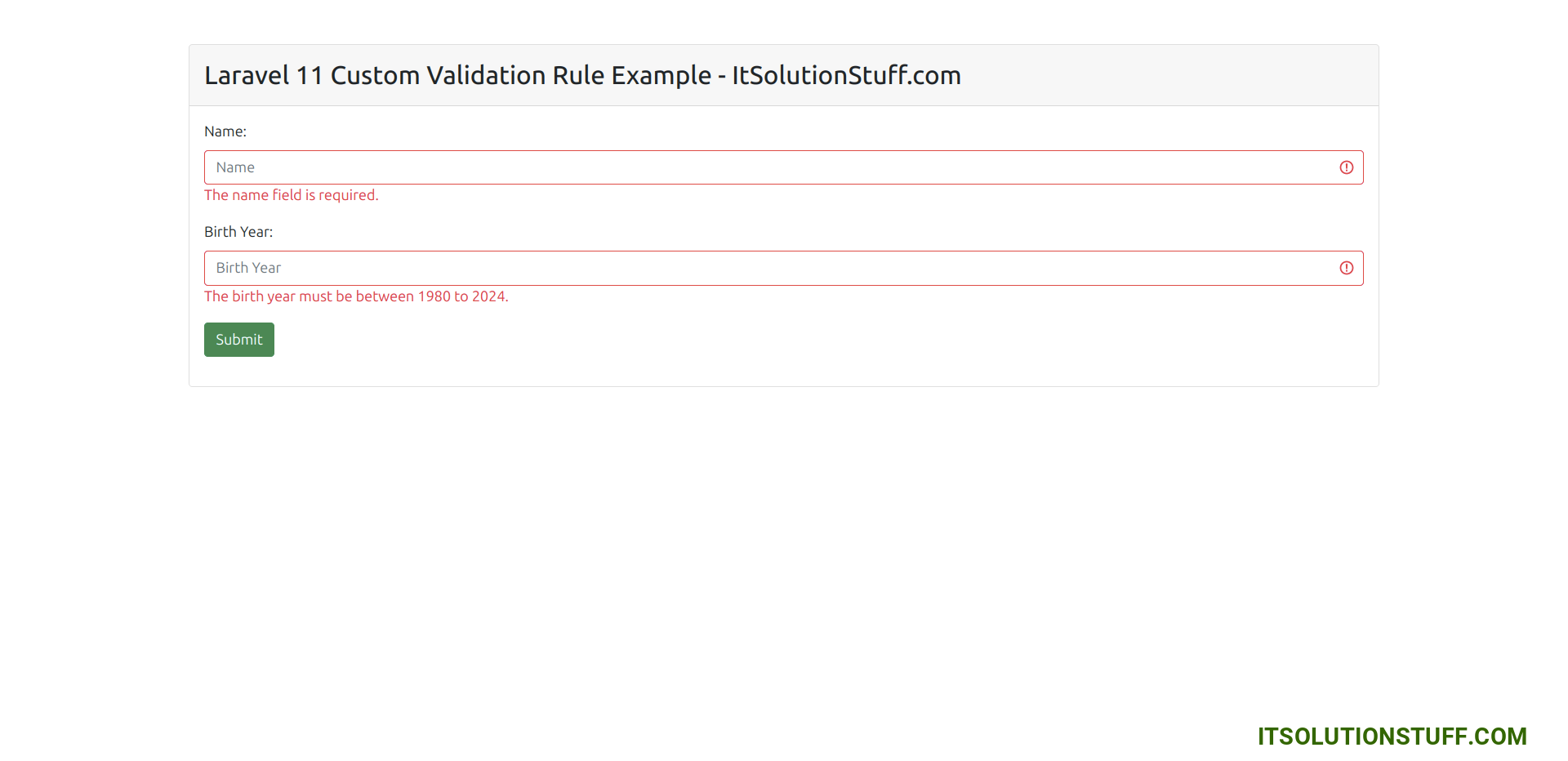How to Create Custom Validation Rules in Laravel 11?
In this post, we will learn how to create custom validation rules in the laravel 11 application.
Laravel provides default validation rules such as email, required, unique, date, and more. If you need to create a custom validation rule in Laravel, I can guide you through the steps.
In this example, we will create a custom validation rule called BirthYearRule. We will add an input text box for birth_year and validate that the user enters a year between 1980 and the current year using our custom validation.

Step for Laravel 11 Make a Custom Validation Rule Example
- Step 1: Install Laravel 11
- Step 2: Create Route
- Step 3: Create Validation Rule
- Step 4: Create Controller
- Step 5: Create View File
- Run Laravel App:
Step 1: Install Laravel 11
First of all, we need to get a fresh Laravel 11 version application using the command below because we are starting from scratch. So, open your terminal or command prompt and run the command below:
composer create-project laravel/laravel example-appStep 2: Create Routes
In this step, we will create two routes: GET and POST for a custom validation rule example. So let's add it.
routes/web.php
<?php
use Illuminate\Support\Facades\Route;
use App\Http\Controllers\CustomValidationController;
Route::get('custom-validation', [CustomValidationController::class, 'create']);
Route::post('custom-validation', [CustomValidationController::class, 'store'])->name('custom.validation.post');
Step 3: Create Validation Rule
In this step, we will create a new "BirthYearRule" validation rule that will check if the user enters a valid year. So let's run the command below and update the rule validation file.
php artisan make:rule BirthYearRuleapp/Rules/BirthYearRule.php
<?php
namespace App\Rules;
use Closure;
use Illuminate\Contracts\Validation\ValidationRule;
class BirthYearRule implements ValidationRule
{
/**
* Run the validation rule.
*
* @param \Closure(string): \Illuminate\Translation\PotentiallyTranslatedString $fail
*/
public function validate(string $attribute, mixed $value, Closure $fail): void
{
if(!($value > 1980 & $value < date('Y'))){
$fail('The :attribute must be between 1980 to '.date('Y').'.');
}
}
}
Step 4: Create Controller
In this step, we have to create a new controller named CustomValidationController, and we also need to add two methods: create() and store() to that controller. We will use the BirthYearRule validation on the store method, so let's update the following code:
app/Http/Controllers/CustomValidationController.php
<?php
namespace App\Http\Controllers;
use Illuminate\Http\Request;
use Illuminate\View\View;
use Illuminate\Http\RedirectResponse;
use App\Rules\BirthYearRule;
class CustomValidationController extends Controller
{
/**
* Show the application dashboard.
*
* @return \Illuminate\Http\Response
*/
public function create(): View
{
return view('forms');
}
/**
* Show the application dashboard.
*
* @return \Illuminate\Http\Response
*/
public function store(Request $request): RedirectResponse
{
$validatedData = $request->validate([
'name' => 'required',
'birth_year' => [
'required',
new BirthYearRule()
]
]);
/*
$validatedData['password'] = bcrypt($validatedData['password']);
$user = User::create($validatedData);
*/
return back()->with('success', 'User created successfully.');
}
}
Step 5: Create View File
In the last step, let's create forms.blade.php (resources/views/forms.blade.php) for the creation form and put the following code:
resources/views/forms.blade.php
<!DOCTYPE html>
<html>
<head>
<title>Laravel Custom Validation Rule Example - ItSolutionStuff.com</title>
<meta charset="utf-8">
<meta http-equiv="X-UA-Compatible" content="IE=edge">
<meta name="viewport" content="width=device-width, initial-scale=1">
<link href="https://cdn.jsdelivr.net/npm/bootstrap@5.0.2/dist/css/bootstrap.min.css" rel="stylesheet">
</head>
<body>
<div class="container">
<div class="card mt-5">
<h3 class="card-header p-3">Laravel 11 Custom Validation Rule Example - ItSolutionStuff.com</h3>
<div class="card-body">
<form method="POST" action="{{ route('custom.validation.post') }}">
{{ csrf_field() }}
<div class="mb-3">
<label class="form-label" for="inputName">Name:</label>
<input
type="text"
name="name"
id="inputName"
class="form-control @error('name') is-invalid @enderror"
placeholder="Name">
@error('name')
<span class="text-danger">{{ $message }}</span>
@enderror
</div>
<div class="mb-3">
<label class="form-label" for="inputEmail">Birth Year:</label>
<input
type="text"
name="birth_year"
id="inputEmail"
class="form-control @error('birth_year') is-invalid @enderror"
placeholder="Birth Year">
@error('birth_year')
<span class="text-danger">{{ $message }}</span>
@endif
</div>
<div class="mb-3">
<button class="btn btn-success btn-submit">Submit</button>
</div>
</form>
</div>
</div>
</div>
</body>
</html>
Run Laravel App:
All the required steps have been done, now you have to type the given below command and hit enter to run the Laravel app:
php artisan serveNow, Go to your web browser, type the given URL and view the app output:
http://localhost:8000/custom-validationOutput: You Email Look Like This

I hope it can help you...

